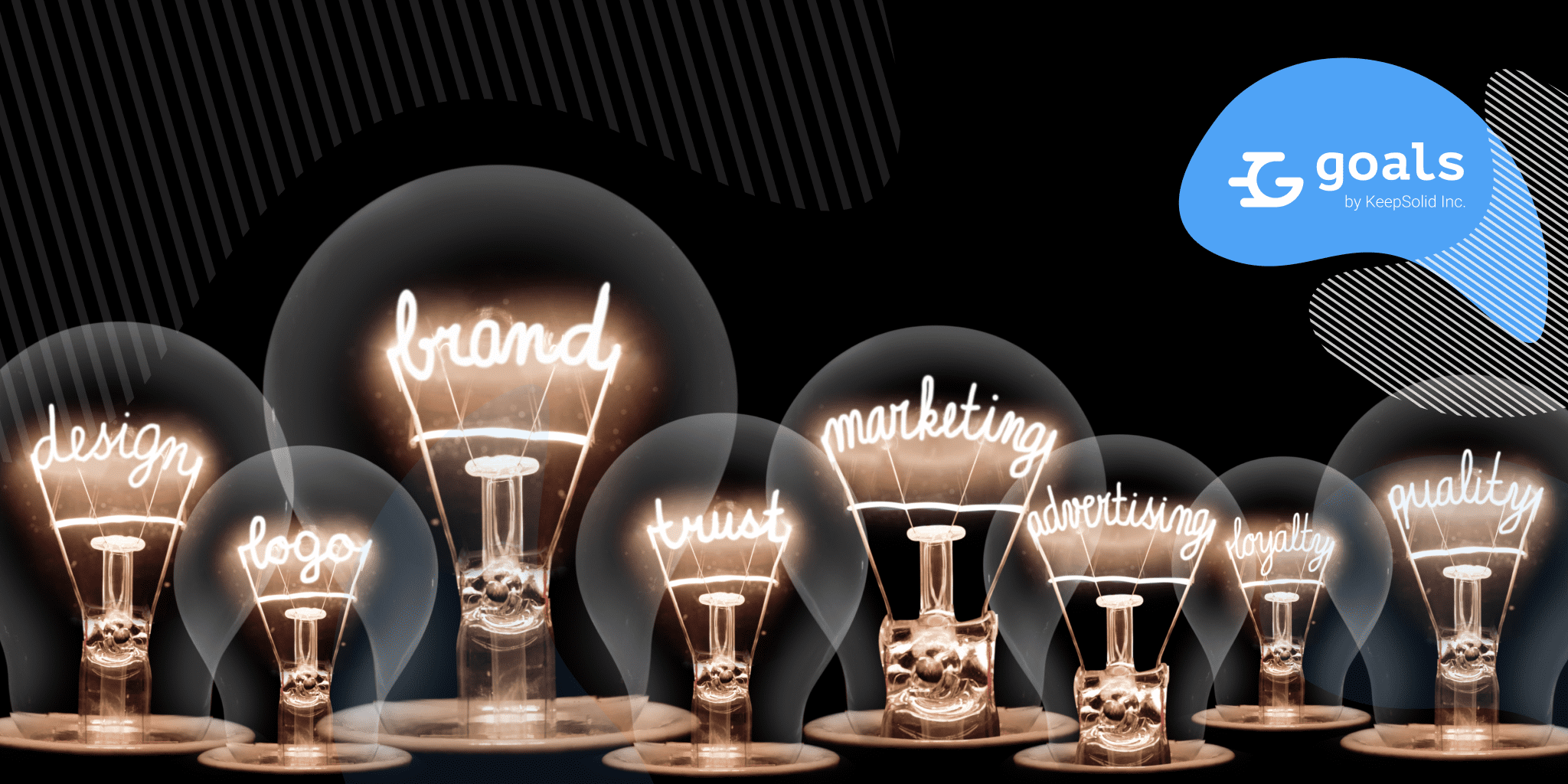In everyday speech, the terms “goals” and “objectives” are pretty much interchangeable. They both refer to an outcome that an individual or a company strives to achieve. However, from a PM standpoint, there are notable differences between the terms. Understanding these nuances is vital for setting correct, clear, and defined goals and objectives, and for seeing them successfully reached.
Wish to increase your and your organization’s chances for success? Then keep reading today’s post by Goals by KeepSolid team and learn all you need to know about the difference between goals and objectives, along with examples of both and some tips on how to create and track them.
Table of contents
- Definition of goals
- Examples of business goals
- Definition of objectives
- Examples of objectives
- 6 differences between objectives and goals
- Benefits of workplace goals
- Benefits of workplace objectives
- How to formulate effective objectives
- How to track goals and objectives
- Aligning goals and objectives
Definition of goals
To understand the difference between goals and objectives, we must first figure out what these terms mean. A goal is an abstract, big-picture, overarching, long-term, short statement of a desired outcome. This statement is usually broad and focuses on the intended results, not the methods and the nitty-gritty of what’s required to achieve them.
Examples of business goals
- Grow profits
- Maximize revenue
- Improve customer service
- Increase management efficiency
- Raise the company’s profile
- Become an industry leader
- Go carbon-neutral and paper-free
Definition of objectives
Objectives are quite different. An objective is a specific, short-term, and actionable target that needs to be achieved, or a set of activities that must be completed in order to reach a set goal. Objectives should be created with the business’ overarching goals in mind. That way, managers and employees will always understand not only what actions are expected of them, but also why, and what part they play in their organization’s performance.
Examples of objectives
- Increase ROI to 15% in a fiscal year
- Add two new product lines by the end of this year
- Grow the company’s market share by 10% by October
- Reduce the operating costs by 12% within a year
- Cut down the response time for customer inquiries to 1 hour by the end of next quarter
6 differences between objectives and goals
As we’ve mentioned earlier, the most prominent difference between a goal and an objective is that the former is the what, and the latter is the how. A goal describes an achievement you intend to get, and an objective determines the actions that will help you meet the goal. Keep this difference in mind as we’re exploring this topic further. Shaping out clear objectives and goals will help your organization make the right business decisions at the right time.

©GIPHY
Here are 6 major differences between objectives and goals:
- Order and alignment
Goals are higher in order and priority than objectives. Goals aim to achieve an individual’s or organization’s mission, and objectives are only valuable insofar as they facilitate the achievement of the goals. - Scope
Goals are broad, they depict intentions that are usually non-measurable. Objectives, on the other hand, are narrower and should always be described in the frame of specific tasks. - Specificity
Goals give you a general understanding of what must be achieved. They do not, nor should they, list specific tasks that will bring you there. That is the job of objectives, to describe concrete actions that are to be performed within a certain time frame. - Language
Goals are usually described in broad concepts, and objectives are described using creative, actionable language. - Tangibility
Goals can be intangible, but objectives should always be defined in tangible targets. For every intangible goal like “improve customer service”, you will need a tangible objective such as “reduce customer wait time to one minute in a month” that will facilitate the achievement of the main goal. - Timeframe
Goals are expected to be achieved over a long time frame, whereas objectives are set for shorter periods. Thus, a single goal is usually divided into a number of objectives that are spread out in time.
Benefits of workplace goals
Understanding the difference between the two, you can utilize goals and objectives to their full potential, and gain all the benefits of each. Goals set the direction for a company’s or an individual’s efforts, even though they don’t describe the methodology itself. Business goals should be aligned with the company’s vision and mission. Individual goals should align with a person’s career aspirations.

Setting compelling and clear goals results in a few key benefits:
- Goals direct and focus your efforts
Similar to a travel destination, goals inform the direction in which you should move. Knowing your destination, you know what direction to move toward, and what actions will better lead you there. - Goals allow you to identify and set your priorities
When you set goals, one thing you consider are various achievements and accomplishments for your future, and which of them are more important to you. Knowing that, having a clear idea about what is, and is not important, makes it easier to set your priorities correctly. This, in turn, will make it clear as to where to focus your efforts, and what activities you can ignore not to waste time. - Goals engage you in achievements
Well-defined goals give you the confidence and conviction. Knowing where you’re going, and how long the road will take, is generally seen as an important trait of successful people. - Goals streamline decision making
Whenever you have to choose between two options or courses of action, if you have clearly set goals, you’ll always know for sure which direction is better. Obviously, the one that takes you toward your goals! - Goals motivate you and your team to act
Meaningful goals are a great motivator. No need to hope to do something someday - you can simply focus on making progress on a daily basis. As a bonus, achieving set goals brings joy, which in itself motivates both individuals and whole organizations to keep reaching new heights. - Goals allow businesses and individuals realize their full potential
Working toward goals helps reach the full potential and capabilities of yourself and your team. You will believe in your capabilities more, which will make it quicker and easier to reach your goals.
Benefits of workplace objectives
And now, here’s how the benefits of objectives are different from those of goals, complementing them. Good business or individual objectives can help you:
- Objectives let you measure your progress
When working toward achieving large goals, you want to be able to monitor your progress, to see if you’re even moving in a set direction. Objectives help you do this. They divide goals into smaller chunks, making them manageable and conquerable. - Objectives provide a sense of accomplishment
Achieving objectives creates a sense of accomplishment. This will motivate you and your team to work even harder to reach your ultimate goals. - Objectives bolster confidence
With defined objectives, you will be able to confirm that your strategy is formulated correctly, that you’re taking the correct steps to realize it, and that overall you can, and will be successful. - Objectives simplify difficult decisions
Whenever you are faced with a difficult decision or situation, unsure what to do, referring to your objectives will help you ascertain that your organization is moving in the right direction. - Objectives translate expectations
Managers and business owners use objectives to set clear, simple, and straightforward targets for their teams. This motivates employees to work toward a common goal and directs their efforts toward it.

How to formulate effective objectives
When planning effective objectives, here are some points to keep in mind:
- Assign Key Performance Indicators (KPIs) or other measurable targets.
- Create different objectives that are relevant for different markets. This will let you vary the desired outcomes for different geographical areas and users.
- Run your objective through multiple rounds of analysis, input, and feedback to refine it. You may find trade-offs between different factors that are worth considering, e.g. improving your customer service in exchange for some amount of efficiency.
- Don’t describe specific actions required to meet your goals as your objectives (that will be covered by Key Results), only the desired outcome.
- See that your objectives are directly related to the company’s end-goals.
- Engage the people who will be responsible for meeting the objectives in the objective setting process.
- Keep your objectives SMART: specific, measurable, achievable, realistic and time-bound (more on this in a bit).
How to track goals and objectives
Understanding the difference between goals and objectives and setting them is one thing; monitoring your progress towards them is another vital aspect. To streamline the latter, we highly recommend using dedicated tools that can incorporate the whole process from beginning (setting goals and objectives) to end (monitoring their completion). A great example of such a tool is Goals by KeepSolid.

Our app utilizes the concept of OKRs (Objectives and Key Results) to help you establish clear connections between:
- Goals (your grand overarching target)
- Objectives (sub-goals that benefit your main goal)
- Key Results (measurable achievements assigned to each objective)
- Tasks (activities that you and your team must complete to reach the key results)
You can visualize all these in different ways, including mind maps, kanban, sprints, and roadmaps. After that, you can easily modify and update your strategies, and monitor their completion and performance via a variety of reports. These features make Goals by KeepSolid a great all-in-one solution for your goal- and objective-setting needs.
If you’re interested in our app, you can start using it right away for free, or you could check out paid Goals subscriptions.
Aligning goals and objectives
To ensure that your goals will actually be met, you must assign measurable objectives to them. And vice versa, you want to give your objectives clear meaning by assigning a broad goal to them. All in all, breaking down goals into measurable objectives makes the former easier and less overwhelming.
To keep your objectives specific, it’s recommended to use the S.M.A.R.T. goal setting method. S.M.A.R.T. goals have to be:
- Specific
- Measurable
- Attainable
- Relevant
- Time-bound
A great thing about this approach is that it will work great for both individual and corporate goals. If you ever feel intimidated with putting a plan together to undertake a long-term goal, consider trying the S.M.A.R.T method. This way, you will break down your goals and assign responsibilities, making it easier for all stakeholders to contribute efficiently.



